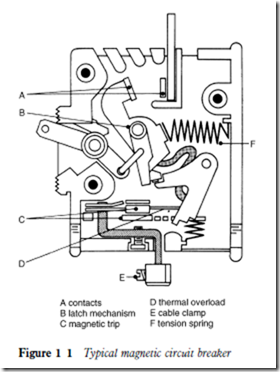Circuit breakers
A fuse element provides protection by destroying itself and must be replaced. It cannot be tested without destruction; therefore the result of a test will not apply to the replacement.
The circuit breaker (CB) is an automatic switch that will open in the event of excess current and can be closed again when a fault is rectified. The switch contacts are closed against spring pressure, and held closed by a form of latch arrangement. A slight movement of the latch will release the contacts quickly under the spring pressure to open the circuit; only excessive currents will operate it.
Two types exist: thermal and magnetic.
Thermal
The load current is passed through a small heater, the temperature of which depends upon the current it carries. The heater will warm up a bimetal strip. When excessive current flows the bimetal strip will warp to trip the latch mechanism.
Some delay occurs owing to the transfer of heat produced by the load current to the bimetal strip. Thermal trips are suitable only for small overloads of long duration. Excessive heat caused by heavy overload can buckle and distort the bimetal strip.
Magnetic
The principle used in this type is the magnetic force of attraction set up by the magnetic field of a coil carrying the load current. At normal currents the
magnetic field is not strong enough to attract the latch. Overload currents will increase the force of attraction and operate the latch to trip the main contacts.
A typical magnetic circuit breaker is shown in Figure 101.
